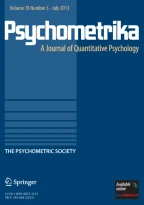Abstract
Restricted multidimensional scaling models [Bentler & Weeks, 1978] allowing constraints on parameters, are extended to the case of asymmetric data. Separate functions are used to model the symmetric and antisymmetric parts of the data. The approach is also extended to the case in which data are presumed to be linearly related to squared distances. Examples of several models are provided, using journal citation data. Possible extensions of the models are considered.
Similar content being viewed by others
Reference Notes
Chino, N.A unified geometrical interpretation of the MDS techniques for the analysis of asymmetry and related techniques. Paper presented at the meeting of the Psychometric Society, Iowa City, May, 1980.
Harshman, R. S.Models for analysis of symmetrical relationships among N objects or stimuli. Paper presented at the meeting of the Psychometric Society and the Society for Mathematical Psychology, McMaster University, Hamilton, Ontario, August, 1978.
Hutchinson, J. W.Network representations of asymmetric data. Paper presented at the Berkeley-Stanford joint meeting in Biological and Cognitive Psychology, Stanford, May, 1980.
Young, F. W.An asymmetric euclidean model for multi-process asymmetric data. Proceedings of the U.S.-Japan Seminar, University of California, San Diego, August, 1975.
References
Bentler, P. M., & Weeks, D. G. Restricted multidimensional scaling models.Journal of Mathematical Psychology, 1978,17, 138–151.
Bishop, Y. M. M., Fienberg, S. W., & Holland, P. W.Discrete multivariate analysis: Theory and practice. Cambridge: MIT Press, 1975.
Bloxom, B. Constrained multidimensional scaling inN spaces.Psychometrika, 1978,43, 397–408.
Constantine, A. G., & Gower, J. C. Graphical representation of asymmetric matrices.Applied Statistics, 1978,27, 297–304.
Coombs, C. H.A theory of data. New York: Wiley, 1964.
Coombs, C. H., Dawes, R. M., & Tversky, A.Mathematical psychology: An elementary introduction. Englewood Cliffs, N.J.: Prentice-Hall, 1969.
Cunningham, J. P. Free trees and bidirectional trees as representations of psychological distance.Journal of Mathematical Psychology, 1978,17, 165–188.
Gower, J. C. The analysis of asymmetry and orthogonality. In J. R. Barra, F. Brodeau, G. Romier, & B. Van Clutsem (Eds.),Recent developments in statistics. Amsterdam: North-Holland, 1977.
Holman, E. W. Monotonic models for asymmetric proximities.Journal of Mathematical Psychology, 1979,20, 1–15.
Takane, Y., Young, F. W., & de Leeuw, J. Nonmetric individual differences multidimensional scaling: An alternating least squares method with optimal scaling features.Psychometrika, 1977,42, 7–67.
Tobler, W. Spatial interaction patterns.Journal of Environmental Systems, 1976,6, 271–301.
Tobler, W. R. Estimation of attractivities from interactions.Environment and Planning A, 1979,11, 121–127.
Author information
Authors and Affiliations
Additional information
This research was supported in part by USPHS Grant 0A01070, P. M. Bentler, principal investigator, and NIMH Grant MH-24819, E. J. Anthony and J. Worland, principal investigators.
The authors wish to thank E. W. Holman and several anonymous reviewers for their valuable suggestions concerning this research.
Rights and permissions
About this article
Cite this article
Weeks, D.G., Bentler, P.M. Restricted multidimensional scaling models for asymmetric proximities. Psychometrika 47, 201–208 (1982). https://doi.org/10.1007/BF02296275
Received:
Revised:
Issue Date:
DOI: https://doi.org/10.1007/BF02296275
